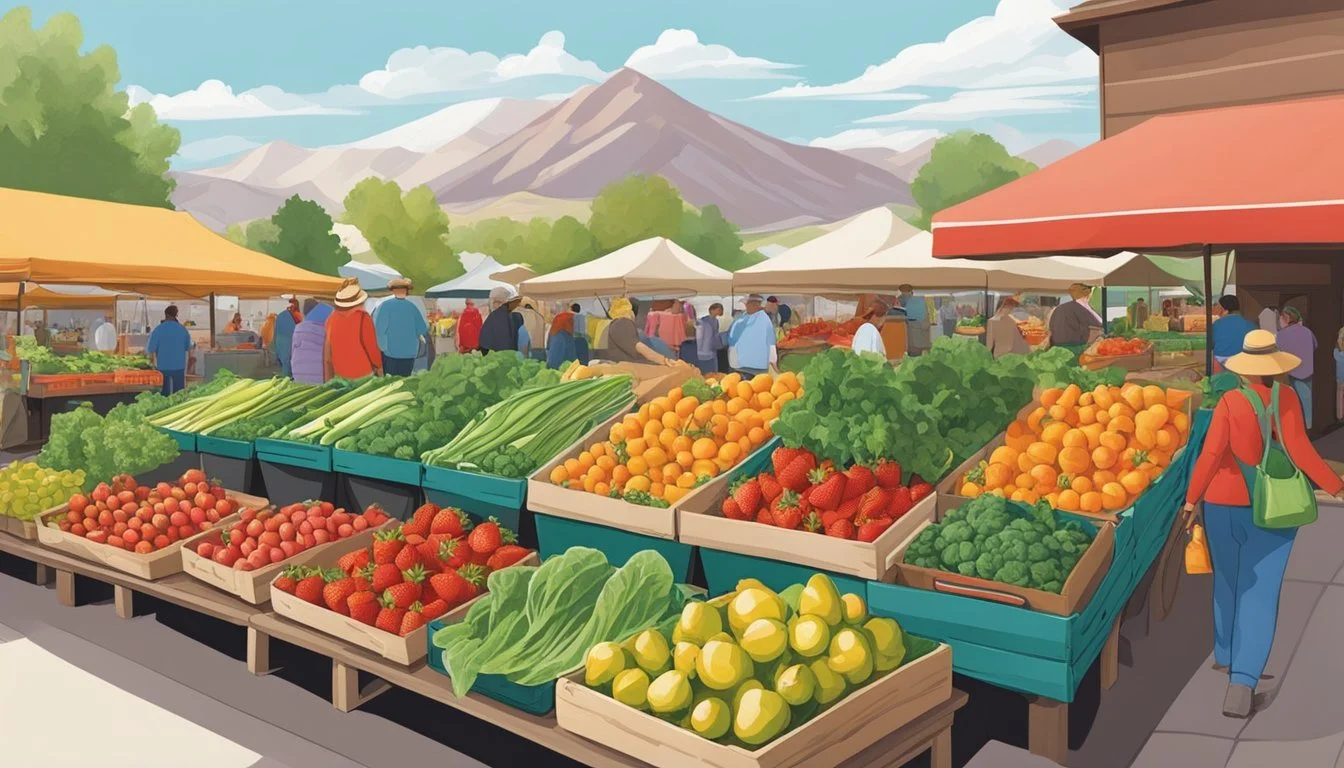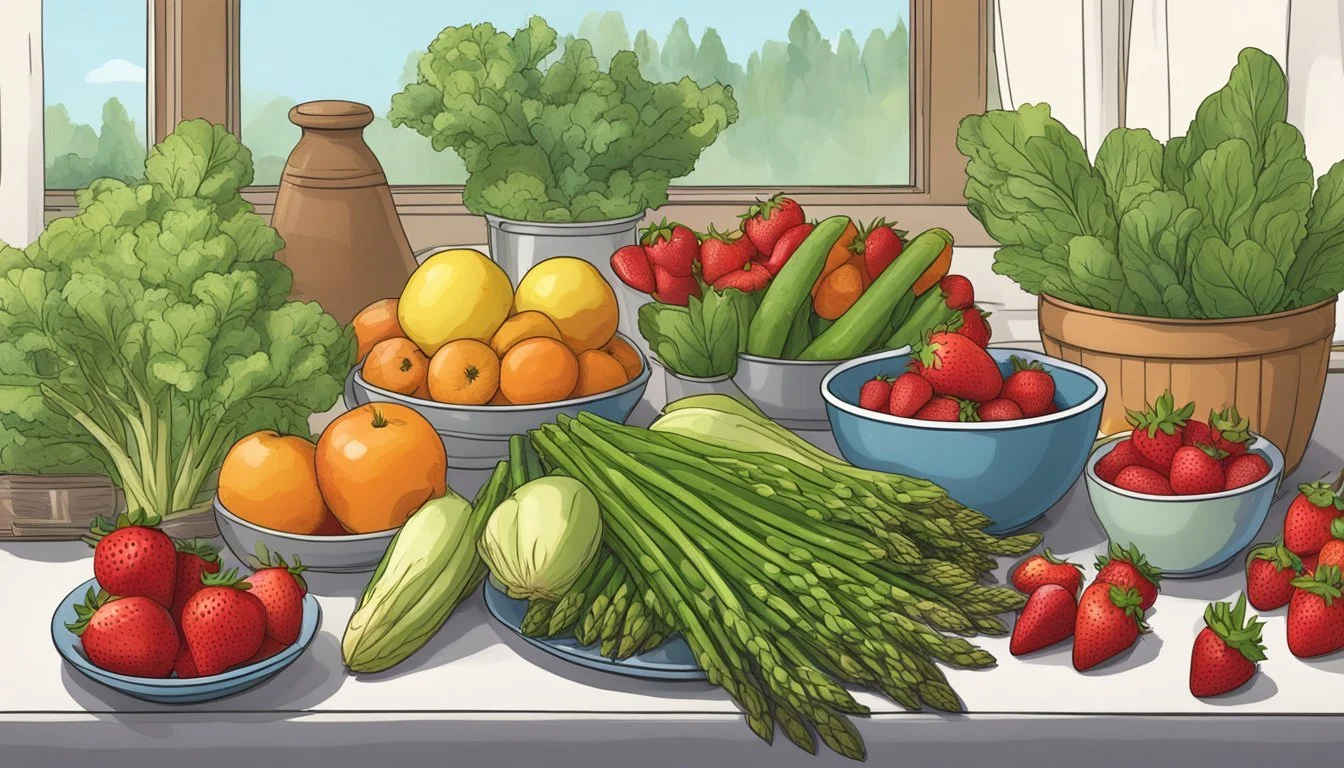Utah Seasonal Fruit & Vegetables in April
Your Fresh Guide
This Article is Part of our Utah Seasonal Fruit & Veg Calendar
As spring breathes new life into the landscapes of Utah, April heralds a time of renewal for local agriculture. The state's seasonal produce begins to emerge, offering a bounty of fruits and vegetables that not only mirror the freshness of spring but also provide an insight into Utah's rich agricultural heritage. This transition period from late winter to early spring is marked by the careful cultivation and harvest of a range of produce, favored by both Utah's locals and its visitors for their freshness and flavor.
During April in Utah, the climate shifts, and with it comes an assortment of crops ready for harvesting. The list of seasonal produce available not only reflects the state’s farming capabilities but also provides consumers with optimal nutrition and taste. Vegetables such as asparagus and various leafy greens like arugula (how long does arugula last?) find their way into local markets. They are often complemented by root vegetables like beets (how long do beets last?), which have wintered well and are ready for enjoyment.
The unique Utah climate, characterized by cold winters and hot summers, shapes a distinctive growing season, setting the stage for what fruits and vegetables can be harvested each month. Farmers in the region work with the land to ensure that the fruits of their labor, which can include crisp, tender greens and hearty vegetables, meet high-quality standards. This commitment guarantees that the selection of seasonal produce available to enthusiasts in April offers a true taste of Utah's agricultural prowess.
Utah's Growing Season
Utah’s growing season begins in earnest during April, with spring temperatures fostering a green revival in gardens and farms across the state.
Spring Specifics
In Utah, the spring season is characterized by a gradual increase in temperatures, which allows a variety of fruits and vegetables to thrive. After the chill of winter subsides, the soil warms up, and frosty nights become less frequent, gardeners and farmers anticipate the time to start sowing seeds.
Typical Spring Temperatures in Utah:
Early Spring: Fluctuates between chilly to mild
Mid to Late Spring: Generally warms up, laying the groundwork for effective planting
Key Vegetation Stages in Spring:
Seedling Stage: When young plants must be protected from potential late frosts.
Transplanting Stage: Typically safer in later spring when the ground is thoroughly warm.
April's Agriculture
During April, Utah’s agriculture shifts into high gear as the risk of frost diminishes. Farmers prepare the soil and start planting crops that can withstand the cool, yet warming, nights of early spring.
Crops Suitable for April Planting in Utah:
Vegetables: Includes peas, spinach, kale, and lettuce, which can endure the cooler temperatures.
Fruit Trees: Begin to bud and require monitoring for signs of pests and diseases.
Utah's growing season in April may still be unpredictable at times, necessitating attentiveness to nightly temperatures and readiness to protect sensitive plants, ensuring a robust start to the season.
Seasonal Fruits Overview
April in Utah signals a shift in the fruit-season calendar, offering an array of flavors indicative of the coming warmer months. This period is marked by the transition of fruit types, with early varieties of berries beginning to emerge and certain tree fruits becoming available later in the month.
Berry Varieties
Strawberries are the heralds of spring fruit in Utah. They deliver a vibrant red color and a sweet, juicy flavor that can vary with the microclimate. The harvest for strawberries usually begins in late April, though timing can fluctuate based on weather patterns.
Raspberries, another seasonal favorite, might not be as prominent in April but some early varieties could start to surface by the end of the month. They are known for their rich red hue and a balance of sweet and tart tastes.
Tree Fruits in April
Tree fruits such as apples are generally not in season during April as they are typically harvested in the fall. However, stored varieties from the previous year’s harvest are still available and retain much of their crisp texture and nuanced flavors.
Peaches and apricots are anticipated seasonal fruits, but their availability in April is limited, as they usually ripen later in the summer. Early varieties of apricots may start to appear by the month's end, their flavors ranging from sweet to tangy depending on the cultivar and current seasonal conditions.
Seasonal Vegetables Guide
April in Utah welcomes the spring season, marking a time for gardeners and farmers to plant and harvest a variety of vegetables. The focus during this month lies in the richness of root vegetables and an assortment of leafy greens and herbs that thrive in the cool yet warming temperatures.
Root Vegetables Selection
In April, the nutrient-dense soil of Utah supports the growth of hearty root vegetables. Potatoes are a staple crop, with many gardeners planting them in early spring for a summer harvest. Carrots and radishes, both known for their crisp texture and vibrant colors, are in season, offering a fresh taste in April's produce repertoire. Beets, another root vegetable, are valued for both their earthy roots and their greens.
Potatoes: best planted in early spring, harvest in summer.
Carrots: optimal for crisp texture, sweet flavor.
Radishes: quick to mature, adds a peppery note.
Beets: known for their versatility, both roots and greens are edible.
Leafy Greens and Herbs
Greens tend to flourish in the cooler but mild April climate of Utah. Lettuce is ready for harvest, providing a base for spring salads with its various types and textures. Kale and arugula, with their slightly bitter profiles, continue to be picked during this month. Spinach also makes an excellent choice for an early spring green, rich in vitamins and minerals. For fresh and aromatic seasoning, one can turn to herbs such as basil (how long does basil last?) and mint, which are just starting to make their appearance in gardens.
Lettuce: several varieties are ready for harvest.
Kale: a hearty green, perfect for salads and sautés.
Arugula: offers a distinctive, peppery taste.
Spinach: a versatile green, high in nutrients.
Basil: begins to sprout, adding aroma to dishes.
Mint: emerges, ready to enhance beverages and desserts.
Farmers Market and Availability
In April, Utah's farmers markets become vibrant community hubs where freshly harvested produce is available, ensuring optimal flavor and nutrition.
Understanding Peak Ripeness
Local farmers efficiently gauge the peak ripeness of their produce, a key factor in the nutritional value and taste of the vegetables and fruit available at the farmers markets. In April, the state's selection typically includes:
Greens: such as spinach and lettuce, which are tender and flavorful.
Root vegetables: like beets and carrots, known for their earthy sweetness.
Cold-tolerant herbs: such as parsley and cilantro, offering fresh aromas.
Local Sources and Selections
Farmers market patrons have the advantage of accessing a diverse selection of produce, directly sourced from within the state. Available produce often includes:
Produce Availability Spinach High Lettuce High Beets Moderate Carrots Moderate Herbs Moderate
Farmers markets not only contribute to the local community by providing fresh options but also support sustainability and the local economy. They are essential for those who prioritize the taste and quality of their produce, ensuring that the offerings are in their most desirable state when presented to consumers.
Culinary Use and Recipes
In Utah, April heralds the arrival of spring produce, which is ideal for light and flavorful dishes. Chefs and home cooks alike take advantage of the fresh herbs and seasonal vegetables to create vibrant salads and sides, as well as delightful desserts that showcase the freshness of the season.
Spring Salads and Sides
Spring in Utah brings a variety of herbs and vegetables perfect for refreshing salads. Watercress, with its peppery flavor, serves as a wonderful base for a spring salad. A simple recipe that highlights watercress might include thin slices of radish and a lemon vinaigrette dressing, creating a crisp and zesty side dish.
For a more substantial side, asparagus emerges as a favored vegetable. Grilled or roasted asparagus can be dressed with olive oil, salt, and freshly chopped herbs such as basil, which comes into season in Utah starting in June. Pairing such sides with a main dish brings a balance of flavor and nutrition to the dining table.
Baking and Desserts
The sweetness of April's seasonal produce in Utah is a perfect excuse to experiment with baking. Recipes like fruit crumbles come alive with the kind of freshness that can only be found in local, in-season fruits. A blueberry crumble, utilizing June-bearing blueberries, is simple yet immensely satisfying, with its buttery topping and juicy fruit center.
Pies are another popular culinary endeavor during this time. While fruit pies are a staple, incorporating seasonal herbs into the crust or filling can add a unique twist. For example, a recipe for strawberry-rhubarb pie becomes elevated with the inclusion of fresh basil, marrying the tartness of the rhubarb with the sweetness of early strawberries and the aromatic basil. These desserts not only capitalize on the flavors of the season but also offer a comforting end to any meal.
Agricultural Challenges in April
In April, Utah's agriculture faces specific challenges due to variable weather patterns and emerging pests that threaten crops. Farmers must navigate these obstacles to ensure healthy yields.
Weather Impact and Management
April in Utah can bring a mixture of late winter and early spring weather, making it a critical month for farmers. Temperature fluctuations can pose a significant risk, with the potential for late frosts that may damage budding fruits and tender vegetables.
Management Strategies:
Monitoring: Keeping a close eye on local weather forecasts.
Frost Protection: Using frost cloths or wind machines to mitigate temperature extremes.
Pest Control and Crop Protection
As the temperature rises, pests begin to emerge and pose a risk to April crops. Effective pest control is crucial to protect the young plants that are particularly vulnerable during this month.
Common Pests:
Aphids and mites can infest young shoots.
Cutworms and wireworms attack seeds and roots.
Crop Protection Methods:
Physical Barriers: Such as row covers to shield plants from insects.
Integrated Pest Management (IPM): Employing a combination of biological control, habitat manipulation, and appropriate chemical treatments.
Supporting Utah's Farms
Utah's local farms play a crucial role in producing seasonal fruit and vegetables, which become available in April. By participating in farm support programs and committing to sustainable practices, one can contribute significantly to the stability and productivity of these agricultural producers.
Community Supported Agriculture
Community Supported Agriculture (CSA) is a proactive way to support local farms in Utah. Members of the community can purchase a "share" of the season's harvest directly from local farms. This financial commitment offers farms early-season capital and allows consumers to enjoy fresh, locally grown produce.
Consumer Benefits: Fresh, Utah-grown fruits and vegetables; often picked within a day of delivery.
Farmer Benefits: Improved financial stability; ability to plan for the season ahead.
Sustainable Practices
Sustainable practices are at the heart of many Utahn farms, ensuring that agricultural methods do not harm the environment. These farms focus on maintaining soil health, water conservation, and reducing the carbon footprint of food production.
Environmental Impact: Reduced use of synthetic chemicals; preservation of local ecosystems.
Long-term Sustainability: Conserving resources for future generations and supporting the farm's ongoing viability.








